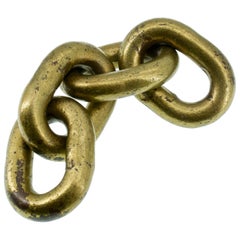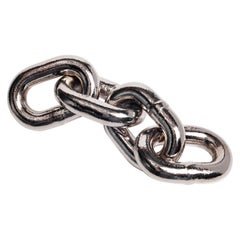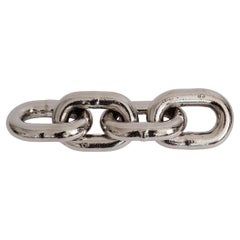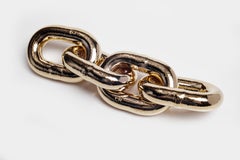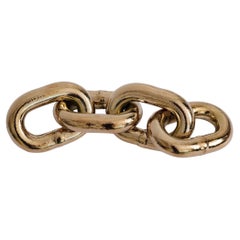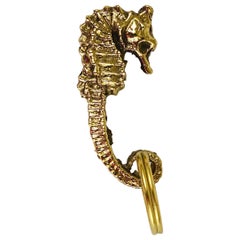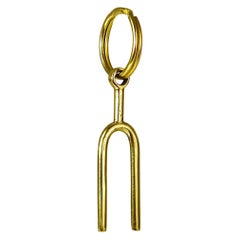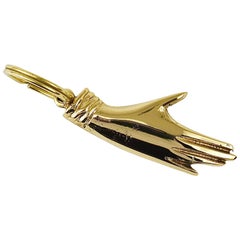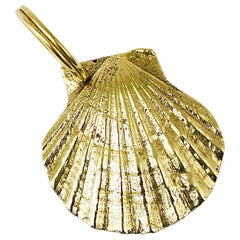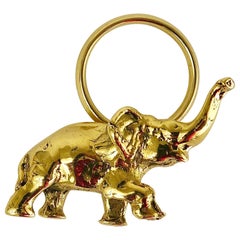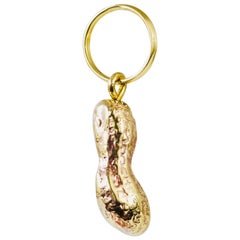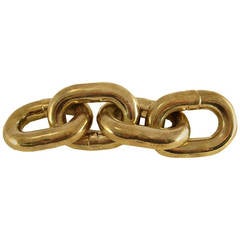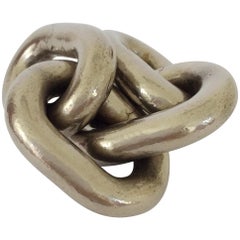Carl Aubock Chain
Vintage 1950s Austrian Mid-Century Modern Paperweights
Steel
2010s Austrian Paperweights
Steel, Nickel
21st Century and Contemporary Austrian Mid-Century Modern Paperweights
Nickel, Iron
2010s Austrian Paperweights
Gold Plate, Steel
21st Century and Contemporary Austrian Mid-Century Modern Paperweights
Iron, Brass
20th Century Austrian Mid-Century Modern Collectible Jewelry
Brass
20th Century Austrian Mid-Century Modern Collectible Jewelry
Brass
20th Century Austrian Mid-Century Modern Collectible Jewelry
Brass
20th Century Austrian Mid-Century Modern Collectible Jewelry
Brass
20th Century Austrian Mid-Century Modern Collectible Jewelry
Brass
21st Century and Contemporary Austrian Mid-Century Modern Collectible Je...
Brass
21st Century and Contemporary Austrian Mid-Century Modern Collectible Je...
Brass
20th Century Austrian Mid-Century Modern Collectible Jewelry
Brass
21st Century and Contemporary Austrian Mid-Century Modern Collectible Je...
Brass
21st Century and Contemporary Austrian Mid-Century Modern Collectible Je...
Brass
20th Century Austrian Mid-Century Modern Collectible Jewelry
Brass
20th Century Austrian Mid-Century Modern Collectible Jewelry
Brass
20th Century Austrian Mid-Century Modern Collectible Jewelry
Brass
21st Century and Contemporary Austrian Mid-Century Modern Collectible Je...
Brass, Nickel
21st Century and Contemporary Austrian Mid-Century Modern Collectible Je...
Brass
Recent Sales
21st Century and Contemporary Austrian Mid-Century Modern Desk Accessories
Brass
Vintage 1960s Austrian Mid-Century Modern Paperweights
Metal
Vintage 1960s Austrian Mid-Century Modern Paperweights
Metal
Vintage 1960s Austrian Mid-Century Modern Abstract Sculptures
Steel, Nickel
Vintage 1960s Austrian Modern Abstract Sculptures
Silver, Bronze
Vintage 1960s Austrian Paperweights
20th Century French Modern Paperweights
Aluminum
People Also Browsed
2010s Italian Chandeliers and Pendants
Murano Glass
2010s American Modern Wall Lights and Sconces
Brass
21st Century and Contemporary Swedish Mid-Century Modern Table Lamps
Textile
21st Century and Contemporary Swedish Scandinavian Modern Wall Lights an...
Metal
2010s Mexican Brutalist Contemporary Art
Wood
2010s Italian Hollywood Regency Chandeliers and Pendants
Brass
Late 20th Century Italian Mid-Century Modern Wall Lights and Sconces
Brass
Vintage 1960s Swedish Scandinavian Modern Beds and Bed Frames
Fir
21st Century and Contemporary Belgian Modern Dining Room Tables
Oak
Mid-20th Century Danish Art Deco Daybeds
Fabric, Oak
21st Century and Contemporary Portuguese Modern Night Stands
Brass, Stainless Steel
2010s Austrian Jugendstil Chandeliers and Pendants
Silk
21st Century and Contemporary American Mid-Century Modern Wall Lights an...
Silver
20th Century Spanish Hollywood Regency Wall Mirrors
Metal, Brass
2010s American Modern Wall Mirrors
Leather, Mirror
21st Century and Contemporary Portuguese Modern Coffee and Cocktail Tables
Metal, Brass, Stainless Steel
Carl Aubock Chain For Sale on 1stDibs
How Much is a Carl Aubock Chain?
Werkstätte Carl Auböck for sale on 1stDibs
In Vienna’s Neubau district, a beautiful Biedermeier townhouse has been home to the Werkstätte Carl Auböck for more than 100 years. Inside the workshop, where production continues to this day, countless objects line the shelves, walls, tabletops and desktops.
The Viennese artist and designer Carl Auböck II was one of the quirkiest and most delightful and collectible of modern designers. A rather odd duck in the world of decorative arts, he was a peculiar talent whose specialties included smaller desk accessories and tabletop pieces such as corkscrews, paperweights, letter openers, bookends and bottle stoppers. He rendered these pieces in a combination of metal — most often brass — and such elemental materials as leather, knobby wood and animal horn, creating forms that could be almost Surrealist, from hands and feet to keys, birds and amoebae.
As a boy, Auböck was precocious and artistic. He studied drawing and at the same time trained in the workshop of his father, Karl Heinrich Auböck, a popular maker of traditional bronze figurines and collectibles. In 1919, Carl II went to Germany to study at the Bauhaus, where he was a pupil of the progressive artist and theorist Johannes Itten. While the Bauhaus is most associated with the rigidly ordered, functionalist architecture of its directors Walter Gropius and Ludwig Mies van der Rohe, the school was in reality a liberal, spirited place — a crucible for imaginative, playful and avant-garde art and design. It was this spirit that imbued Carl II’s work from the time he left in 1921.
In 1922 or ’23, Carl Auböck II returned to Vienna to help care for his ailing father, and he took over the business. He created the Werkstätte Carl Auböck and a legacy that earned his objects cult status among collectors. The business was passed on to his descendants, who run the atelier that is still in operation today. Today, objects designed by Carl II make up 90 percent of Werkstätte Carl Auböck’s production, joined by the creations of architect and designer Carl IV, his grandson.
Vintage Auböck designs have a special character, a patina that only emphasizes how much the pieces have been loved and used. Carl Aubock II’s small furniture items — leather- or caned-sling magazine racks; free-edge wooden side tables with tubular bronze legs; wicker serving trolleys with turned beechwood wheels — are elegant and purposeful. His bijoux desktop objects, library tools, ashtrays and barware pieces evince a kind of mirthful practicality. They seem to ask: “If you need a corkscrew, or a paperweight, or a candlestick, why not make it fun as well as functional?” And indeed, why not?
Find a collection of vintage Werkstätte Carl Auböck mirrors, seating, tables, decorative objects and other furniture on 1stDibs.
A Close Look at Mid-century-modern Furniture
Organically shaped, clean-lined and elegantly simple are three terms that well describe vintage mid-century modern furniture. The style, which emerged primarily in the years following World War II, is characterized by pieces that were conceived and made in an energetic, optimistic spirit by creators who believed that good design was an essential part of good living.
ORIGINS OF MID-CENTURY MODERN FURNITURE DESIGN
- Emerged during the mid-20th century
- Informed by European modernism, Bauhaus, International style, Scandinavian modernism and Frank Lloyd Wright’s architecture
- A heyday of innovation in postwar America
- Experimentation with new ideas, new materials and new forms flourished in Scandinavia, Italy, the former Czechoslovakia and elsewhere in Europe
CHARACTERISTICS OF MID-CENTURY MODERN FURNITURE DESIGN
- Simplicity, organic forms, clean lines
- A blend of neutral and bold Pop art colors
- Use of natural and man-made materials — alluring woods such as teak, rosewood and oak; steel, fiberglass and molded plywood
- Light-filled spaces with colorful upholstery
- Glass walls and an emphasis on the outdoors
- Promotion of functionality
MID-CENTURY MODERN FURNITURE DESIGNERS TO KNOW
- Charles and Ray Eames
- Eero Saarinen
- Milo Baughman
- Florence Knoll
- Harry Bertoia
- Isamu Noguchi
- George Nelson
- Danish modernists Hans Wegner and Arne Jacobsen, whose emphasis on natural materials and craftsmanship influenced American designers and vice versa
ICONIC MID-CENTURY MODERN FURNITURE DESIGNS
- Eames lounge chair
- Nelson daybed
- Florence Knoll sofa
- Egg chair
- Womb chair
- Noguchi coffee table
- Barcelona chair
VINTAGE MID-CENTURY MODERN FURNITURE ON 1STDIBS
The mid-century modern era saw leagues of postwar American architects and designers animated by new ideas and new technology. The lean, functionalist International-style architecture of Le Corbusier and Bauhaus eminences Ludwig Mies van der Rohe and Walter Gropius had been promoted in the United States during the 1930s by Philip Johnson and others. New building techniques, such as “post-and-beam” construction, allowed the International-style schemes to be realized on a small scale in open-plan houses with long walls of glass.
Materials developed for wartime use became available for domestic goods and were incorporated into mid-century modern furniture designs. Charles and Ray Eames and Eero Saarinen, who had experimented extensively with molded plywood, eagerly embraced fiberglass for pieces such as the La Chaise and the Womb chair, respectively.
Architect, writer and designer George Nelson created with his team shades for the Bubble lamp using a new translucent polymer skin and, as design director at Herman Miller, recruited the Eameses, Alexander Girard and others for projects at the legendary Michigan furniture manufacturer.
Harry Bertoia and Isamu Noguchi devised chairs and tables built of wire mesh and wire struts. Materials were repurposed too: The Danish-born designer Jens Risom created a line of chairs using surplus parachute straps for webbed seats and backrests.
The Risom lounge chair was among the first pieces of furniture commissioned and produced by celebrated manufacturer Knoll, a chief influencer in the rise of modern design in the United States, thanks to the work of Florence Knoll, the pioneering architect and designer who made the firm a leader in its field. The seating that Knoll created for office spaces — as well as pieces designed by Florence initially for commercial clients — soon became desirable for the home.
As the demand for casual, uncluttered furnishings grew, more mid-century furniture designers caught the spirit.
Classically oriented creators such as Edward Wormley, house designer for Dunbar Inc., offered such pieces as the sinuous Listen to Me chaise; the British expatriate T.H. Robsjohn-Gibbings switched gears, creating items such as the tiered, biomorphic Mesa table. There were Young Turks such as Paul McCobb, who designed holistic groups of sleek, blond wood furniture, and Milo Baughman, who espoused a West Coast aesthetic in minimalist teak dining tables and lushly upholstered chairs and sofas with angular steel frames.
Generations turn over, and mid-century modern remains arguably the most popular style going. As the collection of vintage mid-century modern chairs, dressers, coffee tables and other furniture for the living room, dining room, bedroom and elsewhere on 1stDibs demonstrates, this period saw one of the most delightful and dramatic flowerings of creativity in design history.
Finding the Right Desk-accessories for You
Whether you’ve carved out a space for a nifty home office or you prefer the morning commute, why not dress up your desk with antique and vintage desk accessories? To best tiptoe the line between desk efficiency and desk enjoyment, we suggest adding a touch of the past to your modern-day space.
Desks are a funny thing. Their basic premise has remained the same for quite literally centuries: a flat surface, oftentimes a drawer, and potentially a shelf or two. However, the contents that lay upon the desk? Well, the evolution has been drastic to say the least.
Thank the Victorians for the initial popularity of the paperweight. The Industrial Revolution offered the novel concept of leisure-time to Europeans, giving them more time to take part in the then crucial activity of letter writing. Decorative glass paperweight designs were all the rage, and during the mid-19th-century some of the most popular makers included the French companies of Baccarat, St. Louis and Clichy.
As paper was exceedingly expensive in the early to mid-19th-century, every effort was made to utilize a full sheet of it. Paper knives, which gave way to the modern letter opener, were helpful for cutting paper down to an appropriate size.
Books — those bound volumes of paper, you may recall — used to be common occurrences on desks of yore and where there were books there needed to be bookends. As a luxury item, bookend designs have run the gamut from incorporating ultra-luxurious materials (think marble and Murano glass) to being whimsical desk accompaniments (animal figurines were highly popular choices).
Though the inkwell’s extinction was ushered in by the advent of the ballpoint pen (itself quasi-obsolete at this point), there is still significant charm to be had from placing one of these bauble-like objets in a central spot on one’s desk. You may be surprised to discover the mood-boosting powers an antique — and purposefully empty — inkwell can provide.
The clamor for desk clocks arose as the Industrial Revolution transitioned labor from outdoors to indoors, and allowed for the mass-production of clock parts in factories. Naturally, elaborate designs soon followed and clocks could be found made by artisans and luxury houses like Cartier.
Find antique and vintage desk accessories today on 1stDibs.
